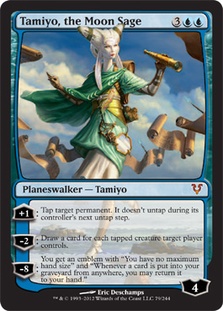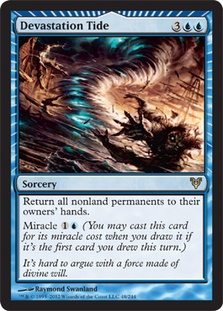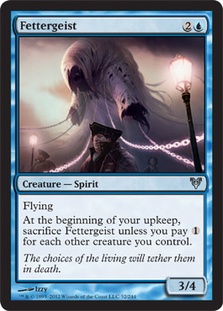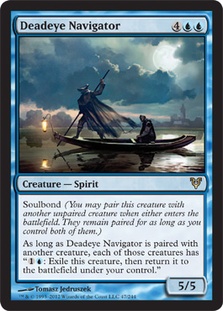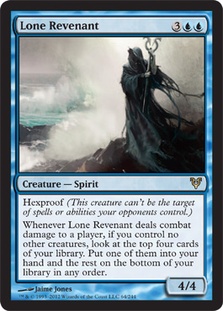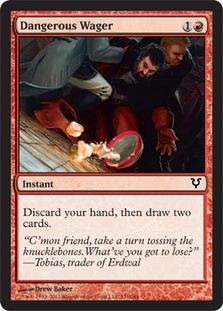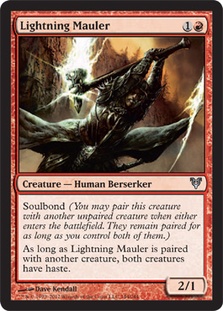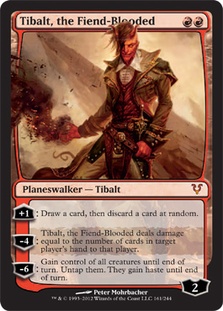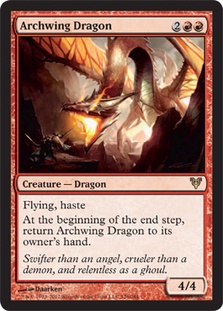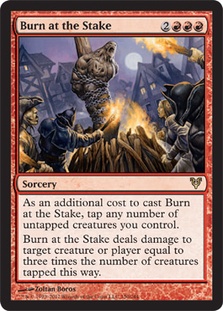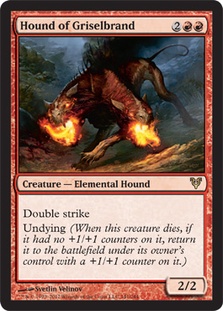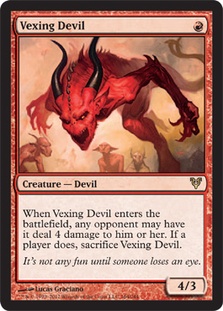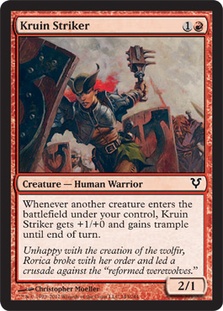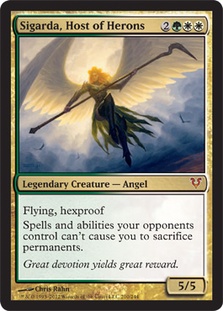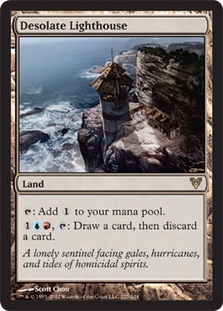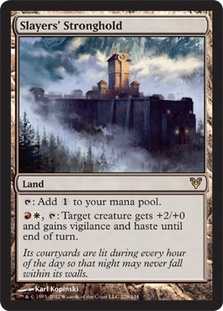Welcome to Part 2 of the StarCityGames.com Avacyn Restored Cube review! Part 1 can be found here.
Blue
Let’s get the easiest card out of the way, Tamiyo. This planeswalker hybrid of Frost Titan, Icy Manipulator, and Gideon Jura is really good. The worth of Tamiyo’s middle ability will be dependent on the deck—you typically won’t want to cast Tamiyo on a board with a bunch of little guys on the opposing side unless you’re using it as a way to break through a stalled gamestate or unless you have many ways to protect Tamiyo against the opposing horde.
If you do have a lot of creatures out, cashing it in for a draw three or four is very good even if it dies to an opposing creature after if it’s going to push you over the top. Most of the time it won’t be used that way, especially in blue sections that are solely devoted to control support. Regardless, even if you ignore her middle ability she’s very good in Cube, if anything, because she helps to lock down opposing threats from the opponent. I’m hoping that the +1 on Tamiyo helps people realize the power of locking down threats in Cube (in other words, I hope it makes more people realize that Frost Titan is good in Cube).
It’s especially important that she protects herself against one of the traditional weaknesses of planeswalkers: manlands (especially ones with evasion like Treetop Village, Celestial Colonnade, and Creeping Tar Pit). Her ultimate is, of course, stupidly good, but almost all ultimates are. Unless you’re intentionally limiting the number of planeswalkers in your cube, Tamiyo is an easy inclusion (and even if you are, you can cut something like Tezzeret the Seeker).
To be honest, I completely dismissed this card until Reuben Bresler started talking about this card in Cube, as fellow Cubist Matt Kranstuber has also been aggressively trying Avacyn Restored cards in his cube—one of the cards being Devastation Tide. I find that with card evaluation (particularly in Cube), people tend to compare cards to others and become overly pessimistic regarding differences in cards; remember when people were nearly universally panning Kargan Dragonlord as a "bad Grizzly Bear that is a RRRRRR 4/4 flier" and that it wasn’t comparable to morph due to instant speed?
In this case, this a version of Upheaval doesn’t bounce lands, and no one plays with Evacuation even at instant speed at five mana. But then again, isn’t Upheaval an extremely high bar to compare cards to and thus, if something even remotely reaches that level, it’s ok? (By the way, apparently people were underrating Upheaval during the Magic Online Cube weekend. Don’t underestimate it; it’s very good and easily in the top five cards in that cube!)
For Cube evaluation, due to the singleton nature of the format we’re going to ignore the miracle cost. This is because it’ll be "mostly gravy" if you can cast it off of miracle, but it’s not likely something that’ll happen even if there are a few cards like Brainstorm and Jace, the Mind Sculptor that can enable that in Cube.
This is what Reuben said when I asked him about Devastation Tide:
"There’s typically no miracle activation, you just play it when you have counterspell backup and they have like two dudes and a planeswalker.
When you bounce their Titan with a counterspell in hand and then you drop a four-drop and a five-drop, you feel gooood."
You have to be more careful and be able to craft a favorable board state after, since you can’t just automatically get a favorable board state after due to all lands being scooped up. It requires more work than simply Upheavaling, which you pretty much have to float a ton of mana, subtract six, and then craft a favorable board state afterwards because you aren’t necessarily guaranteed to have a favorable board position once your opponent passes their post-Tide turn (which you can all but guarantee with Upheaval).Â
It’s very possible to craft a favorable board state in the way that Reuben described. I’ve found in testing that U/G decks also like this card since they can have mana Elves "feed themselves" with their own mana, play something huge like a Wolfir Silverheart / Chameleon Colossus, or a cheap planeswalker, and protect it with cheap permission.
There’s the argument that the opponent will just replay everything afterwards, which isn’t necessarily true. For example if the opponent goes turn 4 Jace, the Mind Sculptor into turn 5 Razormane Masticore. Sure, they can re-deploy cards after, but you’ll, at least in theory, be able to craft your hand to be able to deal with those opposing threats and post-bounce board state to "deal with what matters" afterwards. Carlos Romao would be so proud! Or at least you can use it as a miser’s mass-bounce to buy yourself some time if need be.
Granted, I haven’t had as much time as I would have liked to test the card after talking to Reuben about it. I’m still not 100% convinced on the card in Cube (and I don’t have room for it in my cube), and I’m wondering if my initial impression of "bad Upheaval" is the correct one. It’s definitely an interesting card, that’s for sure.
When I first saw this card, I thought that it counted all creatures for its upkeep and thought about its acceptable threshold for how much is the most that you’d want to pay to upkeep Fettergeist (and I thought about four mana) and that even if it required a one mana upkeep for him being a solitary creature, that was more than fine. As it turns out, if he’s a solitary creature he doesn’t have a drawback! Although big evasive creatures like Serendib Efreet (the most direct and easiest comparison) are at their best in tempo-style and aggressive decks (although something like Serendib is still very good in control decks or decks with Islands for that matter), Fettergeist is going to end up leaning more towards the non-aggro side than Serendib Efreet did.
While it gets awkward once you have to start spending two to three mana for its upkeep and it’s definitely awkward in U/G decks with a lot of mana creatures as you’re essentially Kataki-ing your mana guys, you probably either won’t be including it in decks that have that number of creatures or you won’t care since you’re beating in with a 3/4 flier in addition to your other guys. That’s really good even when not compared to something like Serendib Efreet but other three-mana evasive beaters in other colors like Flickerwisp and Dauthi Marauder.
I find that people tend to overstate drawbacks, especially of aggressive creatures, in Cube, and Fettergeist’s drawback is one of the easier ones to deal with. It’s difficult to say whether Serendib Efreet or Fettergeist is better in Cube (I’d say Serendib Efreet), but I honestly don’t think you really need to make that comparison. You can go for the "easy change" by substituting one for the other, as they’re both stellar in Cube and there should be room for both.
Six mana is an interesting slot for finishers, and Deadeye Navigator isn’t like a lot of the traditional ones at six mana in blue: Frost Titan, Sphinx of Jwar Isle, Consecrated Sphinx, and Keiga, the Tide Star. It can be easy to dismiss Deadeye Navigator as a "bad Dragon" as it’s much worse at the "slam this down and win" role, especially since it doesn’t really pass the Terminate test all that well.
But if you’re able to untap with Deadeye, it can very easily defend itself as Deadeye can either blink itself or its paired creature. Its best use, however, is as a blink enabler; being able to blink something like a Murderous Redcap, Kitchen Finks, or even an evoke creature like Mulldrifter is no joke, as cards like Crystal Shard, Venser the Sojourner, and Mimic Vat have taught us the power of repeated enters the battlefield triggers. The Magical Christmasland scenario of turn 5 Cloudgoat Ranger, followed by Deadeye, followed by blinking it three times will likely result in a very dead opponent, and that scenario doesn’t really seem that far off.
It’s hard to say whether something like one of the more traditional finishers is better than this. People, myself included, tend to think that the traditional finishers are better (when the Titans were printed, many people thought that the Esper Kamigawa Dragons were better than the Esper Titans when they’ve shown to be worse—at least for Grave and Sun Titan). I’m thinking that this card would be worse, at least in the vein of traditional finisher, but whether it provides more to a cube overall is another question. As a card that combines with other enters the battlefield creatures and may give another card powerful blink strategies (a strategy that’s getting more love with cards like Restoration Angel), it may be worth considering in another year if it doesn’t make the grade now if cubes get more good blink cards.
A lesson about "saboteur" creatures without evasion that many Cubists have learned is that ones like Augury Adept and Dimir Cutpurse are lackluster because they lack evasion. The ones that survive and live on in many cubes like Thieving Magpie, Lu Xun, Scholar General, Ohran Viper, and Shadowmage Infiltrator all have evasion. The only exception is something like Geist of Saint Traft, a creature that, as it turns out, makes up for having a lack of evasion through insane efficiency (and a bit of evasion with the 4/4 Angel token.) Like Geist, one thing important to note is that hexproof means that it won’t just die to a Path (but it will to a Wrath) and that like Geist, you can attack only when you really want to.
The "lone" thing shouldn’t be too hard to support like with Fettergeist, especially in the control decks with few win conditions and ones like manlands/planeswalkers as supplementary threats as Impulsing is very nice. Still, the lack of evasion does seem like an issue in a color with a lot of competition for finishers (including Tamiyo), which will keep it out of many cubes.
Red
Dangerous Wager is another card that suffers from comparisons to really strong cards—mainly Wheel of Fortune and also possibly "Giant Solifuge Syndrome." For those playing along, when Giant Solifuge was unofficially spoiled a blurry picture made it look like a 4/3 instead of a 4/1. Thus, many people were disappointed as the 4/1 "died to every creature ever." Dangerous Wager looks like it may be suffering that same pain, as it was initially thought to let you draw three cards, but like Solifuge being a 4/3, I don’t think it’d be possible for Dangerous Wager to let you draw three cards (especially at common).
Cheap draw three effects have usually asked for people to jump through hoops: making the opponent make the first move for it like Standstill, making you find a way to destroy your own enchantment with Hatching Plans, or waiting several turns like Ancestral Vision. The condition for asking red decks to empty their hands isn’t a particularly hard one for red-based aggressive decks to hit. I’ve heard people say that it’s unplayable because you have to empty your hand, but that really isn’t that much of a drawback for aggressive red decks. Sometimes you’ll have to pitch something that you really want to cast so you can try to draw the burn spell, and if that’s the right call, as painful as it is, it’s the right call.
The big question is whether it’s worth playing it over a creature, burn, equipment, or disruption spell. With cards like Reckless Charge / Faithless Looting and others like Chandra, the Firebrand, their worth comes from multiple uses and overall efficiency in use (more so with Reckless Charge and arguably Faithless Looting), but it’s hard to say whether it ends up being worth the slot. In testing, I found that its drawback really wasn’t that bad as the red decks were able to empty their hands anyway, but whether I have room for it in my cube is another matter. I ultimately found that I didn’t have enough room for it. In my common cube, though, it’s a much easier inclusion.
Say hello to the best red card in Cube from Avacyn Restored! Red has lived and died by the strength of its red two-drops in Constructed with cards like Keldon Marauders defining the archetype, and Lightning Mauler looks to be a spicy addition. Typically it plays very well as it effectively has haste by soulbonding with my one-drop and attacking for two.
Honestly, I’d cube with a 1R 2/1 haste all day in Cube as I’ve wanted one for years. I didn’t find that it gave other creatures haste as the opponent usually just preferred to kill the Mauler instead of the one-drop, and while the "blowout" of having your one-drop die pre-combat can happen, it’s really not that bad even when it does happen as it makes all of your other creatures have haste from that point onward.
Tibalt has been one of the harder cards from the set to evaluate, as it covers a lot of new ground and is an innovative design for not only planeswalkers but Magic in general. Part of the problem in its evaluation is thinking of it too much with regards to other cards, like looters, and thinking of it too much as a planeswalker.
Wait, what?
With many planeswalkers, we’re used to being able to use their abilities once a turn no matter what to reach a final goal of either using their ultimate or riding it out for value, with a few exceptions in cards like Sarkhan the Mad, Liliana of the Veil, and Gideon Jura. With the exception of ones like Liliana and Sarkhan the Mad, we’re used to being able to use their +1 ability for value (even if the value is relatively low, like Ajani Goldmane’s +2 life ability) and are disappointed if we can’t do that.
With Tibalt, it can be disappointing to not be able to use his +1 ability because your hand quality is that good, but it’s perfectly fine if you aren’t able to use his +1 ability because you soon will (in the red-based aggressive decks where he’ll find his home). Tibalt does violate one of the principles of good planeswalkers: being able to protect itself (but then again, Jace Beleren couldn’t protect himself either), and Tibalt isn’t a very good topdeck.
With traditional looters, you don’t really need to think about whether you want to activate the ability or not. Ryan Spain and Marshall Sutcliffe repeatedly told their listeners on Limited Resources that unless your hand was absolutely perfect, choosing to not loot when a looter wasn’t summoning sick was a big mistake; fearing that you’d have to discard a good card was just that, living in fear.
With Tibalt, you have to be more careful with looting and it requires more thought. With traditional looters you’d just say "EOT loot," but with Tibalt you have to figure out if drawing + random discard will have an overall positive or negative impact on your hand. In testing in Cube red decks, I found that the aggressive red/X decks were able to easily cast the spells in their hands and were able to have their overall hand quality improve by +1ing Tibalt, as they could cast the spells in hand easily due to their cheap costs.
The -4 was a nice thing to work towards, and the final ultimate was mostly gravy. Much like Dangerous Wager, the big question is whether Tibalt contributes more to a game victory than a solid two-mana burn spell like Searing Blaze or Smash to Smithereens. Ultimately, I would say that the burn spell does more and that’s what’s likely going to keep him out of my cube (and if I do include him, I don’t think he’ll have a long shelf life).
Word of Seizing is a card that’s on the outside looking in on many cubes, as the effect is about one mana too much for the effect on its own even if it can steal opposing permanents as opposed to creatures and if it has split second. I’ve always wanted for red to have a way to have this effect in my cube, but I didn’t want to pay that much mana for it.
Enter Zealous Conscripts, which trades at instant speed and split second for a 3/3 body with haste. The haste is especially important because it lets you push through the last points of damage to finish off the opponent in aggro (along with whatever permanent you stole, probably whatever blocker the opponent left behind). Much like Restoration Angel, Zealous Conscripts has a ton of uses: from its likely most common use of stealing creatures, to stealing planeswalkers, to even things like taking an opponent’s Maze of Ith so it can’t fog a creature. There’s lots of flexibility in this card. I’ve never found a five-drop red creature other than Siege-Gang Commander that I’ve liked that much in Cube, but Conscripts is a welcome addition.
Archwing Dragon is another in the line of creatures that isn’t so much a creature but more a burn spell in creature form. Despite it being more of a burn spell than a creature, it doesn’t really compare favorably to a lot of red four-drops or even Hell’s Thunder. Hell’s Thunder’s unearth does provide for some countermagic/removal/hand disruption insurance, even if that costs one mana more on the unearth side than casting Archwing Dragon.
There aren’t many spells that have the damage potential of Burn at the Stake (it being not hard to get nine to twelve damage out of it), and it can be easy to outright dismiss it on a worst case scenario basis. Unlike Overrun, it does guarantee damage going through no matter what blockers the opponent has. Much like Overrun, it’ll be very good in token decks that want to deal the last points of damage, and it arguably does that task better since the damage is more consistent, which is especially important if the opponent is at low life. I’m highly considering this card if only because the potential is very good, but I wouldn’t be terribly surprised if its time in my cube doesn’t last long.
Alas, much like with Archwing Dragon, I must make the inevitable comparison to other four-drops in red, all of which have an immediate board impact aside from ones like Moltensteel Dragon (which is really a four-drop) and other non-red ones like Masticore and Bloodline Keeper. Initially, I didn’t think much of Hound of Griselbrand because of this, but then someone compared it to Phantom Centaur.
There are definite differences: Hound of Griselbrand is better versus smaller sources of damage but worse versus black and gets stronger when it dies instead of weaker. Double strike is very good, especially on 2+ power with burn and other equipment types of things. Undying is such a good mechanic as Geralf’s Messenger and Vorapede has taught us. However, I’m still not 100% on board with the Hound as I’m already not running Moltensteel Dragon and I’m not convinced that this is better than the Dragon.
It’s been talked about a lot, but it’s much more of a four mana Lava Spike with a drawback than an actual 4/3. "Punisher" cards can be strange in Cube, but the best are ones where the opponent gets a bad part of the deal no matter what—cards like Fact or Fiction, Liliana’s ultimate, Land Tax, or even (when the opponent has other creatures) cards like Hellspark Elemental. Red-based aggressive decks are definitely a thing in Cube and Vexing Devil can support that strategy, but I don’t think that it does it well enough. Why? It’s too narrow.
Pure burn spells aren’t that good in Cube because of their inflexibility. Brimstone Volley is really the closest to a player-only burn spell in Cube (unless you want to count ones like Hell’s Thunder and Smash to Smithereens, and in the case of Hell’s Thunder it promises a lot more overall damage). When the opponent is in burn mode, unfortunately Vexing Devils can’t reliably finish off an opponent.
Vexing Devils can help the opponent to reach that level of life, but it still offers the opponent a choice. Despite Vexing Devils looking like a 4/3 for R, it’s definitely not a turn 1 play. It’s probably something closer to a turn 4 or 5 play. In testing, I found that it only was a 4/3 twice:Â once when the opponent had removal for it, and the other time was early in the match when it made the opponent’s Skinrender live. Aside from that, it’s been an early four damage Lava Spike.
I really wanted to like this card for my regular cube; it’s better than cards like Mogg Conscripts that can’t attack unless you play another creature that turn, but the one toughness is quite harsh on this creature as the opponent will try their best to block Kruin Striker as much as possible. It’s best to treat this as a 3/1 in a format like common cubes. It’s interesting in an aggro deck with a token theme with creatures like Siege-Gang Commander and Midnight Haunting, but it’s on the outside looking in for many "regular" cubes.
Others
While the other Angels in the three-card cycle don’t really do enough for their costs (and the aura ability on the U/W is pretty worthless in Cube), Sigarda is definitely a good one for Cube. Despite its awkward cost of 2WWG (as opposed to something like GGW, which would make splashing easier for green-based decks) and ignoring its "sacrifice" ability which mainly acts as a subtle black hoser (nice since both are enemy colors of black), it’s still a 5/5 hexproof for five!
I’ve found that it isn’t terribly hard to cast it on turn 5 in G/W decks, but even when cast on turn 6 it has been very good and stands toe-to-toe with some of the best creatures in the game. The fact that the opponent has to have a mass-removal spell like Wrath of God to deal with it is also really good. People have been considering taking cards like Mirari’s Wake out of their cube for Sigarda and that sounds right. It’s not as good as the really strong universally playable G/W cards like Kitchen Finks and Qasali Pridemage, but it’s still really good and arguably the third best G/W card.
Looting is very good for both blue-based decks and red decks that want to get rid of excess cards, making Desolate Lighthouse a very good land to splash in either archetype (and obviously it’s extremely good in U/R decks.) While it may seem like the ability is expensive, I’m really not sure if it’d be possible to print this with a U/R activation. Even still, having an ability that’s useful with the opportunity cost of tapping for a color of mana is very good. It’s one of the better spell lands in the set, being worse than only than cards like Kessig Wolf Run and arguably Gavony Township.
A common misconception that I hear about why aggro decks are bad in Cube is because "things like Savannah Lions suck on turn 8." Granted, your game plan is that they don’t reach that stage of the game in aggro, but this land helps get a lot of extra value out of your early drops when the games go late or when you’re top decking small creatures. Haste is probably the best part of the land’s ability, but the +2/+0 is really good for taking things like Savannah Lions to the point where the opponent has to keep your ability to deploy hasty threats in mind at all times (and vigilance isn’t too bad either, but the combination of haste and power pumping is really solid).Â
Alchemist’s Refuge is definitely the worst out of the multicolor-aligned lands for Cube. I’ve heard people saying that this is marginally better than Winding Canyons, a card that doesn’t make it into cubes because of its inefficiency. While it’s true that a lot of the time it’s going to allow creatures to be cast EOT, its flexibility in even letting things like non-Rout mass-removal and artifacts like mana rocks get cast EOT gives it a lot more value.
Like with the other lands, whether it makes it into your cube or not mainly depends on what it’s competing with. It’s not better than a land like Simic Signet, but it’s better than lower-end U/G land options like Yavimaya Coast and Flooded Grove. For cubes that have a general land section where Barbarian Ring is in the same section as City of Brass, it may be a hard inclusion, but it’s definitely not bad. Sadly, it’s the worst out of a really good cycle from this set.
I hope that you’ve enjoyed this look at Avacyn Restored for Cube and that it’s given you some options for your cube’s red, blue, and miscellaneous sections!
May all of your opening packs contain Sol Rings!
@UsmanTheRad on Twitter
My blog featuring my cube lists: http://idratherbecubing.wordpress.com — including Avacyn Restored changes to my cube!
Cube podcast that I and Anthony Avitollo co-host: The Third Power

